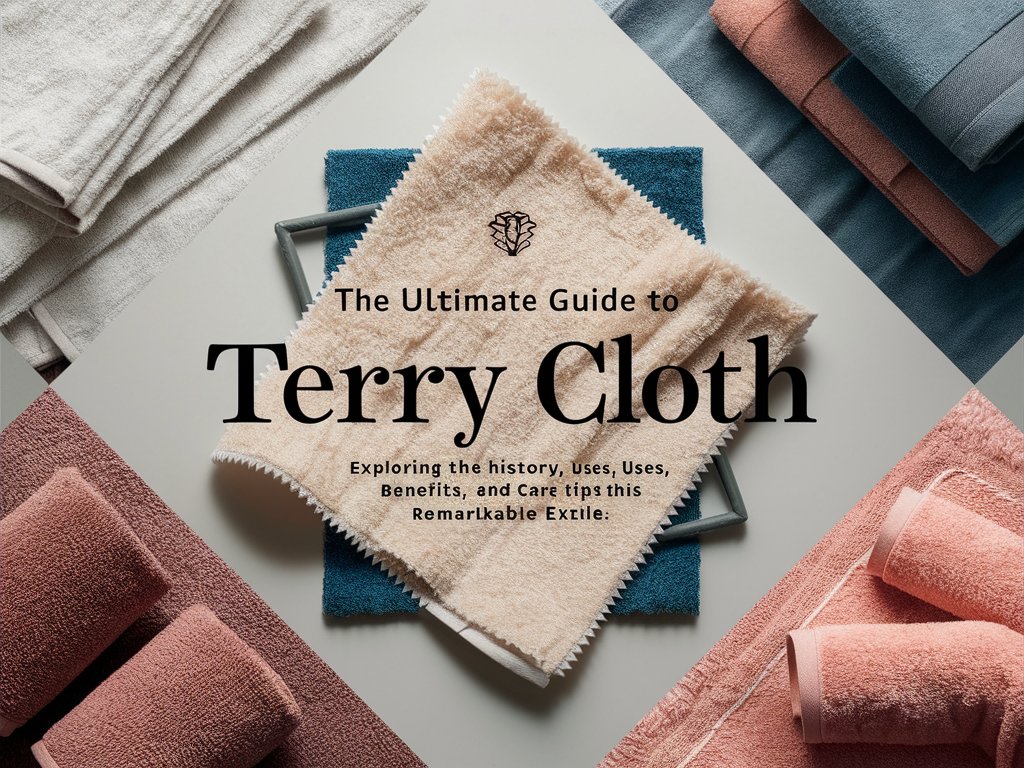Terry cloth, a staple fabric in many households, is known for its softness, absorbency, and versatility. From luxurious bathrobes to durable towels, this fabric plays a significant role in our daily lives. This comprehensive guide will explore the history, uses, benefits, and care tips for terry cloth, providing you with all the information you need to appreciate and utilize this remarkable textile.
What is Terry Cloth?
Cloth, also known as terrycloth or terry toweling, is a type of fabric characterized by its looped pile surface on both sides. These loops create a larger surface area, enhancing the fabric’s absorbency. They can be made from various materials, including cotton, polyester, and blends, but 100% cotton is the most popular due to its natural softness and absorbency.
History of Terry Cloth
It has a rich history that dates back to the 19th century. It was invented in the 1840s in the town of Paisley, Scotland. The name “terry” comes from the French word “tirer,” meaning “to pull,” referring to the method used to create the loops on the fabric. Initially, It was used primarily for towels, but its uses have since expanded to various products, including bathrobes, baby products, and even upholstery.
Types of Terry Cloth
There are several types of cloth, each with distinct characteristics suited for different purposes:
1. Standard Terry Cloth
Standard cloth features loops on both sides, making it highly absorbent and ideal for towels and bathrobes. It’s soft and durable, providing comfort and longevity.
2. French Terry Cloth
French cloth has loops on one side and a smooth, flat surface on the other. It’s lighter and more breathable, commonly used for casual clothing like sweatshirts and lounge pants.
3. Microfiber Terry Cloth
Made from synthetic fibers like polyester, microfiber terry cloth is incredibly soft, lightweight, and quick-drying. It’s often used for cleaning cloths and athletic wear.
4. Organic Cloth
Organic cloth is made from organic cotton, free from harmful chemicals and pesticides. It’s an eco-friendly option, perfect for those with sensitive skin or who prefer sustainable products.
Uses of Terry Cloth
Terry cloth’s versatility makes it suitable for a wide range of products:
1. Towels
It is most commonly associated with towels. Its absorbent loops make it perfect for bath towels, hand towels, and washcloths, providing efficient moisture wicking and softness.
2. Bathrobes
The plush texture and warmth of cloth make it an excellent choice for bathrobes. These robes offer comfort and absorbency, ideal for wearing after a shower or bath.
3. Clothing
French cloth is often used in casual wear, including sweatshirts, hoodies, and lounge pants. Its lightweight nature and softness make it comfortable for everyday wear.
4. Baby Products
Terry cloth is gentle on the skin, making it suitable for baby towels, bibs, and washcloths. Its absorbency helps keep babies dry and comfortable.
5. Cleaning Cloths
Microfiber cloth is highly effective for cleaning surfaces, as it can pick up dirt and grime without scratching. It’s commonly used for cleaning windows, cars, and electronics.
6. Upholstery
They can also be used for upholstery, providing a soft and durable covering for furniture. It’s often found in beach chairs and poolside lounges.
Benefits of Terry Cloth
They offers numerous advantages, making it a preferred fabric for many applications:
1. Absorbency
The looped structure of cloth increases its surface area, allowing it to absorb large amounts of moisture. This makes it ideal for towels and bathrobes.
2. Softness
Cloth, especially when made from cotton, is incredibly soft to the touch. This makes it comfortable against the skin, whether in towels, bathrobes, or clothing.
3. Durability
The strong fibers and looped construction of cloth make it durable and long-lasting. It can withstand frequent washing and use without losing its shape or texture.
4. Breathability
It is breathable, allowing air to circulate and keep you cool. This is particularly beneficial for clothing items like sweatshirts and pants.
5. Versatility
Terry cloth’s wide range of uses, from bath towels to casual clothing, demonstrates its versatility. It can be used in various settings, providing comfort and functionality.
6. Eco-Friendliness
Organic cloth is an eco-friendly option, reducing the environmental impact of production. It’s also biodegradable and free from harmful chemicals.
Also Read: When Doubled get my Innuendo: The Art of Clever Wordplay
How to Care for Terry Cloth
Proper care is essential to maintain the softness and durability of cloth. Here are some tips to keep your terry cloth items in top condition:
1. Washing
- Use mild detergent and avoid bleach, which can weaken the fibers.
- Wash terry cloth items separately to prevent lint transfer.
- Use warm water for washing to maintain absorbency and softness.
2. Drying
- Tumble dry on low heat to prevent shrinkage and maintain fluffiness.
- Remove items promptly from the dryer to avoid wrinkles.
3. Stain Removal
- Treat stains promptly with a mild stain remover.
- Avoid using fabric softeners, as they can reduce absorbency.
4. Storage
- Store terry cloth items in a cool, dry place to prevent mildew and odors.
- Avoid overloading storage spaces to maintain the shape and texture of the fabric.
Choosing the Right Terry Cloth Products
When selecting cloth products, consider the following factors:
1. Material
- Opt for 100% cotton for maximum softness and absorbency.
- Choose organic options if you prefer eco-friendly products.
2. Weight
- Heavier terry cloth is more absorbent and plush, suitable for towels and bathrobes.
- Lighter terry cloth is better for clothing and baby products.
3. Construction
- Look for tightly woven loops for durability and longevity.
- Ensure even loop distribution for consistent absorbency.
4. Brand and Quality
- Choose reputable brands known for high-quality terry cloth products.
- Read reviews and customer feedback to gauge product performance.
The Future of Terry Cloth
As sustainability becomes increasingly important, the future of cloth looks promising with innovations focusing on eco-friendly production methods. Organic and recycled materials are gaining popularity, reducing the environmental impact of cloth products. Additionally, advancements in textile technology are leading to the development of more durable and efficient cloth fabrics.
Conclusion
Terry cloth is a versatile and indispensable fabric in our daily lives. From its historical origins to its modern-day applications, cloth has proven its worth through its absorbency, softness, and durability. Whether you’re looking for luxurious bath towels, cozy bathrobes, or comfortable clothing, cloth offers an ideal solution. By understanding its benefits and proper care, you can enjoy the comfort and functionality of cloth products for years to come.







